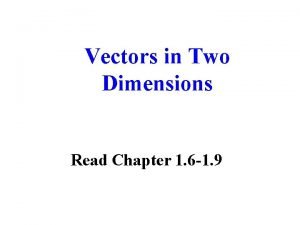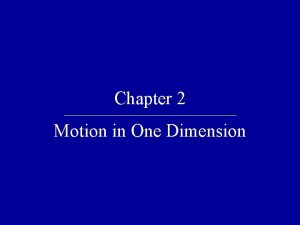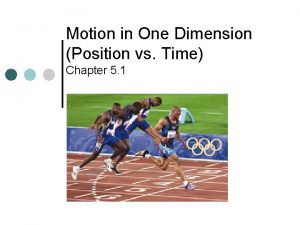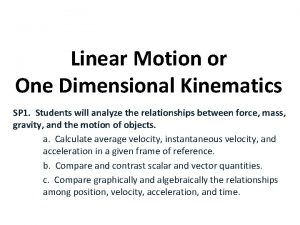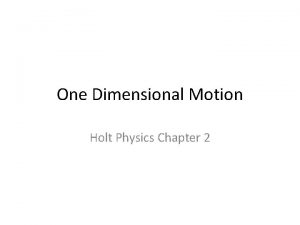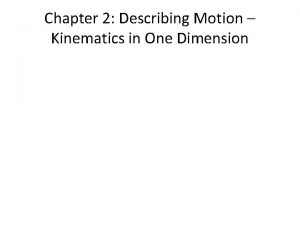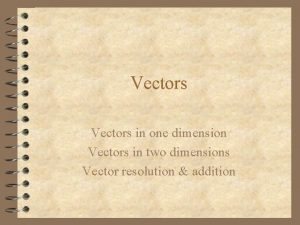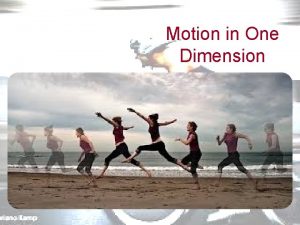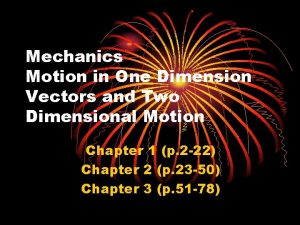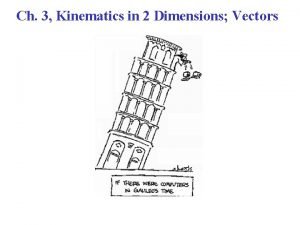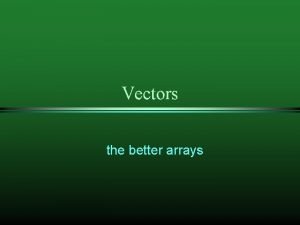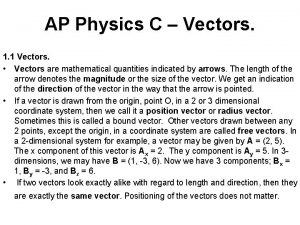Vectors in one dimension Vectors in two dimensions

















- Slides: 17

Vectors in one dimension Vectors in two dimensions Vector resolution & addition

Review: Vectors vs. Scalars One of the numbers below does not fit in the group. Can you decide which one? Why? 35 ft 161 mph -70° F 200 m 30° East of North 12, 200 people The answer is: 200 m 30° East of North

Adding Vectors Case 1: Collinear Vectors

Adding Vectors in one dimension When vectors are parallel, just add magnitudes and keep the direction. Ex: 10 mph east + 7 mph east = 17 mph east + +10 mph +7 mph The Resultant is: +17 mph

Adding Collinear Vectors When vectors are antiparallel, just subtract the smaller magnitude from the larger and use the direction of the larger. Ex: 50 mph east + 40 mph west = 10 mph east +50 m -40 m The Resultant is: 10 m

Vectors in two dimensions �Expressing direction using a compass: N = 0 deg N E = 90 deg S = 180 deg W = 270 deg W N is also E 360 deg S

Adding Vectors Case 2: Perpendicular Vectors

Adding Perpendicular Vectors When vectors are perpendicular, just sketch the vectors in a HEAD TO TAIL orientation and use right triangle trigonometry to solve for the resultant and direction.

Head-to-Tail Rule �The rule for adding vector v to vector u is: �Head-to-Tail Rule: Move vector v (keeping its length and orientation the same) until its tail touches the head of u. �The sum is the vector from the tail of u to the head of v. u+v v u

Adding Perpendicular Vectors R θ Use Pythagorean Theorem to solve for R and Right triangle trig. To solve for θ

Adding Perpendicular Vectors Use the Pythagorean Theorem and Right Triangle Trig. to solve for R and q…

Adding vectors in 2 dimensions �A person walks 10 km N and 6 km E What is his/ her displacement? 10 km 6 km R How do you find the resultant, R?

Steps to solving this problem 1. Use Pythagorean to find the magnitude. Equation c 2 = a 2 + b 2 = (10 km)2 + (6 km)2 = 100 km 2 + 36 km 2 = 136 km 2 So the magnitude c = (136 km 2)1/2 = 11. 7 km 2. Use Tangent to find the angle. Inv Tan (6 km / 10 km) = 30. 96 deg or 31. 0 deg 3. State the direction in degrees from North. The person has ended up 31. 0 deg from N (or E of N)

Summary 1. use the Pythagorean theorem to find the magninitude 2. Use the INV Tangent to find the angle 3. Decide the direction

Vector Components �Vectors can be described using their components. �The Components of a vector are two perpendicular vectors that would add together to yield the original vector. �Components are notated using subscripts. R Ry Rx

Adding vectors in 2 dimensions �A person walks 10 km N and 6 km E What is their displacement? 10 km 6 km R How do you find the resultant, R?

Vector Components 15 km 45 deg from N Find the y component; y is the opposite side Y component = hyp * Sin A 45 deg X component = hyp * Cos A = 10. 6 km Find the x component; x is the adjacent side
 Vectors in one dimension
Vectors in one dimension Structure of twelfth night
Structure of twelfth night 2^x=256
2^x=256 Vectors in 2 dimensions
Vectors in 2 dimensions Motion in one dimension quiz
Motion in one dimension quiz To describe a position in more than one dimension
To describe a position in more than one dimension 1 dimensional kinematics
1 dimensional kinematics Chapter 4: forces in one dimension answer key
Chapter 4: forces in one dimension answer key Chapter 2 motion in one dimension answer key
Chapter 2 motion in one dimension answer key Holt physics motion in one dimension answers
Holt physics motion in one dimension answers Chapter 4 forces in one dimension
Chapter 4 forces in one dimension Free fall motion in one dimension
Free fall motion in one dimension Undefined terms worksheet
Undefined terms worksheet Classification of research methods
Classification of research methods Motion in one dimension
Motion in one dimension Describing motion kinematics in one dimension
Describing motion kinematics in one dimension Describing motion kinematics in one dimension
Describing motion kinematics in one dimension 2d motion equations
2d motion equations



